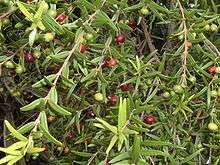Eugenia
| Eugenia | |
|---|---|
 | |
| Eugenia sprengelii | |
| Scientific classification | |
| Kingdom: | Plantae |
| (unranked): | Angiosperms |
| (unranked): | Eudicots |
| (unranked): | Rosids |
| Order: | Myrtales |
| Family: | Myrtaceae |
| Subfamily: | Myrtoideae |
| Tribe: | Myrteae |
| Genus: | Eugenia L.[1] |
| Type species | |
| Eugenia uniflora L. | |
| Species | |
|
About 1,000; see text | |
| Synonyms[2] | |
|
List
| |
Eugenia is a genus of flowering plants in the myrtle family Myrtaceae. It has a worldwide, although highly uneven, distribution in tropical and subtropical regions. The bulk of the approximately 1,000 species occur in the New World tropics, especially in the northern Andes, the Caribbean, and the Atlantic Forest (coastal forests) of eastern Brazil. Other centers of diversity include New Caledonia and Madagascar. Many species new to science have been and are in the process of being described from these regions. For example, 37 new species of Eugenia have been described from Mesoamerica in the past few years. At least 20 new species are currently in the process of being described from New Caledonia, and approximately the same number of species new to science may occur in Madagascar. Despite the enormous ecological importance of the myrtle family in Australia (e.g. Eucalyptus, Corymbia, Angophora, Melaleuca, Callistemon, Rhodamnia, Gossia), only one species of Eugenia, E. reinwardtiana, occurs on that continent. The genus also is represented in Africa south of the Sahara, but it is relatively species-poor on that continent. In the past some botanists included the morphologically similar Old World genus Syzygium in Eugenia, but research by Rudolf Schmid in the early 1970s convinced most botanists that the genera are easily separable. Research by van Wyk and colleagues in South Africa suggests the genus may comprise at least two major lineages, recognizable by anatomical and other features.
All species are woody evergreen trees and shrubs. Several are grown as ornamental plants for their attractive glossy foliage, and a few produce edible fruit that are eaten fresh or used in jams and jellies.
Eugenia species are sometimes used as food plants by the larvae of hepialid moths of the genera Aenetus (including A. splendens) and Endoclita (including E. damor and E. malabaricus). Aenetus species burrow horizontally into the trunk then vertically down. Other Lepidoptera larvae which feed on Eugenia include Eupseudosoma aberrans and Snowy Eupseudosoma.
The genus was named in honor of Prince Eugene of Savoy.[3]
Selected species
- Eugenia aurata O.Berg
- Eugenia angustissima O.Berg – Needle-leaf Cherry
- Eugenia axillaris Sw.Willd.[4]
- Eugenia beaurepairiana – Visconde Uvaia
- Eugenia bimarginata DC.
- Eugenia blastantha (O.Berg) D.Legrand
- Eugenia brasiliensis Lam. – Grumichama (Brazil)
- Eugenia brejoensis Mazine[5]
- Eugenia candolleana – Rainforest Plum
- Eugenia capensis – Dune Myrtle, Eastern Cape Myrtle (South Africa)
- Eugenia cerasiflora Miq.
- Eugenia cereja D.Legrand – Mountain Cherry
- Eugenia confusa
- Eugenia copacabanensis – Copacabana Beach Pitanga (Atlantic Coast restingas in the state of Rio de Janeiro, Brazil)
- Eugenia coronata
- Eugenia dysenterica DC. a.k.a. Stenocalyx dysentericus O.Berg
- Eugenia earthiana (Costa Rica)
- Eugenia fernandopoana
- Eugenia florida – Rainforest Cherry, Guamirim Cereja
- Eugenia foetida
- Eugenia fulva
- Eugenia hiemalis Cambess.
- Eugenia involucrata – Cherry of the Rio Grande
- Eugenia klotzschiana O.Berg
- Eugenia koolauensis O.Deg – Koʻolau Eugenia, Nioi (Islands of Molokaʻi and Oʻahu in Hawaii)
- Eugenia lamprophylla
- Eugenia ligustrina
- Eugenia livida O.Berg
- Eugenia luschnathiana Klotzsch & O.Berg – Pitomba (Bahia, Brazil)
- Eugenia lutescens – Field Uvaia, Field Perinha, Sweet Uvainha
- Eugenia mabaeoides Wight.
- Eugenia mattosii – Pitanguinha
- Eugenia modesta
- Eugenia monticola
- Eugenia nitida – Pitanga-juba
- Eugenia orbiculata
- Eugenia petrikensis
- Eugenia pitanga (O.Berg ex Mart.) Kiaersk. – Pitanga-peba, Creeping Pitanga
- Eugenia pluriflora Mart.
- Eugenia polyantha
- Eugenia punicifolia (Kunth) DC.
- Eugenia pyriformis Brazil – Uvaia, uvalha
- Eugenia pyriformis x lutescens – Rugosa Uvaia
- Eugenia reinwardtiana (Blume) DC. – Mountain Stopper, Cedar Bay Cherry, Beach cherry (Queensland in Australia, Indonesia, Pacific Islands)
- Eugenia roxburghii DC.
- Eugenia selloi – Pitanga-tuba, Pitangola
- Eugenia singampattiana Beddome
- Eugenia sprengelii
- Eugenia stipitata McVaugh – Arazá (Amazon Rainforest)
- Eugenia supraaxillaris
- Eugenia truncata
- Eugenia umtamvunensis (South Africa)
- Eugenia uniflora L. – Suriname Cherry, pitanga (Neotropics)
- Eugenia uruguayensis Cambess.
- Eugenia victoriana northern South America – Guayabilla
Formerly placed here
Many species formerly placed in Eugenia have been moved to Syzygium.
References
| Wikimedia Commons has media related to Eugenia. |
| Wikispecies has information related to: Eugenia |
- ↑ "Genus: Eugenia L.". Germplasm Resources Information Network. United States Department of Agriculture. 2009-01-27. Retrieved 2010-12-12.
- ↑ "WCSP". World Checklist of Selected Plant Families. Retrieved March 8, 2014.
- ↑ Stearn, W. T. (2004). Botanical Latin. Portland, Oregon: Timber Press.
- ↑ Wunderlin, R. P., and B. F. Hansen. 2008. "Eugenia axillaris". Atlas of Florida Vascular Plants (http://florida.plantatlas.usf.edu/Plant.aspx?id=2831).[S. M. Landry and K. N. Campbell (application development), USF Water Institute.] Institute for Systematic Botany, University of South Florida, Tampa.
- ↑ Fiorella Fernanda Mazine and Viniciu Castro Souza (2008), A new species of Eugenia (Myrtaceae) from north-eastern Brazil Botanical Journal of the Linnean Society, volume 158, issue 4, pages 775–777.